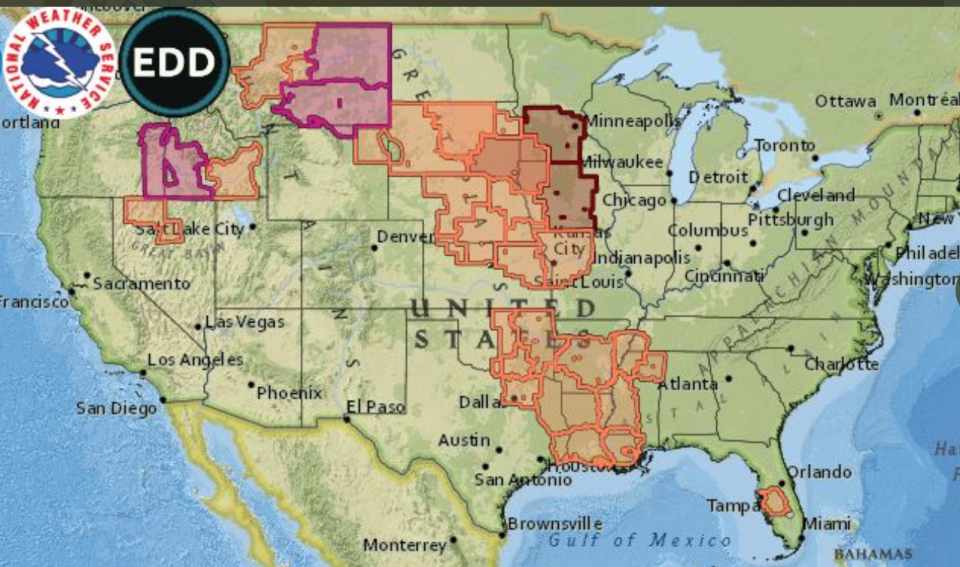Heatwave to hit much of US bringing temperatures up to 20 degrees higher than average

A heatwave will bring triple-digit temperatures to much of the United States this week, testing power grids and fuelling dozens of wildfires ablaze across the country.
Heat alerts are in place across at least 16 states in the south, midwest and western United States, impacting over 35 million people, with temperatures as much as 20 degrees higher than average expected to challenge record highs.
Once humidity is factored in, the temperature for much of the country will feel hotter than 100F (38C).
The hot spell is being caused by a heat dome which is likely to settle over the US in the coming days, trapping heat in the atmosphere.
And according to a new study published in Nature, “record-shattering” temperatures are going to become two to seven times more frequent than in the last 30 years.
In the Pacific Northwest, an excessive heat warning remained in place in southwestern Idaho until midnight on Monday, with the National Weather Service warning of “dangerously hot” temperatures set to reach 106F (41.1C).
Idaho has 23 active wildfires, the most of any state, which have so far burned over 192,000 acres.
High temperatures are expected to remain over 100F (38C) until Tuesday night.
The Pacific Northwest has suffered hundreds of fatalities during an extended heatwave last month, as the extreme heat caused power cables to melt and roads to buckle in Seattle this summer.
In parts of central, south central, and southeast Montana temperatures were expected to reach up to 110F (43.3C) on Monday.
The National Weather Service said it would be even hotter on Tuesday, before a cold front on Tuesday night was expected to bring some relief.
In South Dakota, St Louis, Missouri, and parts of Washington state, heat indexes could reach more than 110F.
The extended high ridge is causing concern among firefighters battling the more than 80 major wildfires currently burning across the western United States.
By Wednesday, the Central US states of Kansas and Nebraska will experience the highest temperatures in the nation, up to 20 degrees above average, the National Weather Service reported.
“The warm temperatures aloft, along with the ongoing drought should create highs from 90 to 110 degrees,” said the NWS in Aberdeen, South Dakota.
In Louisiana, a heat advisory is already in place for almost the entire state, as well parts of Oklahoma, Tennessee and Mississippi.
In Texas, the power grid operator said demand would reach a record high over the next week as homes and businesses crank up their air conditioners to battle the heat wave.
Houston reached 97F (36C) on Monday, and is expected to reach the 90s every day between July 22 and August 2.
The state’s power grid failed during a deadly winter storm in February, leaving millions of people without power.
According to the US National Ocean Service, a heat dome occurs when ridges of high pressure become lodged in the Earth’s atmosphere, trapping mountains of warm air beneath them.
In explaining what causes the heat domes, scientists from the National Ocean Service found the main cause was a “strong change in ocean temperatures from west to east in the tropical Pacific Ocean during the preceding winter”.
The new study, published on Monday in Nature, found that if current greenhouse gas emissions continue, heat waves could become 21 times more likely by 2050.
Even after dozens of national record-breaking temperatures in 2021, report co-author Erich Fischer, a climate scientist at ETH Zurich, said: "We haven’t seen anything close to the most intense heat waves possible under today’s climate, let alone the ones we expect to see in the coming decades".
Read More
Chances of ‘record-shattering’ heatwaves to soar without urgent climate action, research warns
Heatwaves and forest fires: Why extreme temperatures are so deadly
Four photos reveal terrifying speed of Dixie fire as it grows to six times size of San Francisco
New ‘destructive’ level of extreme weather alert to be texted to phones from next month
Biden reverses Trump rollback and tightens limits on toxic pollution from coal power plants

 Yahoo Movies
Yahoo Movies 